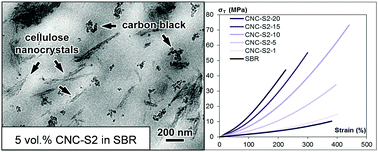当前位置:
X-MOL 学术
›
Soft Matter
›
论文详情
Our official English website, www.x-mol.net, welcomes your
feedback! (Note: you will need to create a separate account there.)
Rubber materials from elastomers and nanocellulose powders: filler dispersion and mechanical reinforcement†
Soft Matter ( IF 2.9 ) Pub Date : 2018-03-09 00:00:00 , DOI: 10.1039/c8sm00210j Matthieu Fumagalli 1, 2, 3, 4, 5 , Julien Berriot 5, 6, 7 , Benoit de Gaudemaris 5, 6, 7 , Anne Veyland 5, 6, 7 , Jean-Luc Putaux 1, 2, 3, 4, 5 , Sonia Molina-Boisseau 1, 2, 3, 4, 5 , Laurent Heux 1, 2, 3, 4, 5
Soft Matter ( IF 2.9 ) Pub Date : 2018-03-09 00:00:00 , DOI: 10.1039/c8sm00210j Matthieu Fumagalli 1, 2, 3, 4, 5 , Julien Berriot 5, 6, 7 , Benoit de Gaudemaris 5, 6, 7 , Anne Veyland 5, 6, 7 , Jean-Luc Putaux 1, 2, 3, 4, 5 , Sonia Molina-Boisseau 1, 2, 3, 4, 5 , Laurent Heux 1, 2, 3, 4, 5
Affiliation

|
Rubber materials with well-dispersed fillers and large mechanical reinforcement have been obtained by melt-processing a diene elastomer matrix and tailored nanocellulose powders having both a high specific surface area and a modified interface. Such filler powders with a specific surface area of 180 m2 g−1 and 100 m2 g−1 have been obtained by freeze-drying suspensions of short needle-like cellulose nanocrystals (CNCs) and entangled networks of microfibrillated cellulose (MFC) in tert-butanol/water, respectively. A quantitative and toposelective filler surface esterification was performed using a gas-phase protocol either with palmitoyl chloride (PCl) to obtain a hydrophobic but non-reactive nanocellulose interface, or with 3,3′-dithiopropionic acid chloride (DTACl) to introduce reactive groups that can covalently bind the nanocellulose interface to the dienic matrix in a subsequent vulcanization process. A set of filled materials was prepared varying the filler morphology, interface and volume fraction. Transmission electron microscopy images of ultrathin cryo-sections showed that modified nanocellulose fillers presented a relatively homogeneous distribution up to a volume fraction of 20%. The materials also exhibited a significant modulus increase, while keeping an extensibility in the same range as that of the neat matrix. Strikingly, in the case of the reactive interface, a strong stress-stiffening behavior was evidenced from the upward curvature of the tensile curve, leading to a large increase of the ultimate stress (up to 7 times that of the neat matrix). Taken together, these properties, which have never been previously reported for nanocellulose-filled elastomers, match well the mechanical characteristics of industrial carbon black or silica-loaded elastomers.
中文翻译:

弹性体和纳米纤维素粉末制得的橡胶材料:填料分散和机械增强†
通过对二烯弹性体基体和具有高比表面积和改性界面的定制纳米纤维素粉末进行熔融加工,可获得具有良好分散的填料和较大机械强度的橡胶材料。这种比表面积为180m 2 g -1和100m 2 g -1的填料粉末是通过将短针状纤维素纳米晶体(CNCs)和微纤化纤维素(MFC)缠结网络的悬浮液冷冻干燥而获得的。叔-丁醇/水。使用气相方案与棕榈酰氯(PCl)进行定量和拓扑选择性的填料表面酯化反应,以获得疏水但非反应性的纳米纤维素界面,或与3,3'-二硫代丙酰氯(DTACl)引入反应基可以在随后的硫化过程中将纳米纤维素界面与二烯基质共价结合。制备了一组填充材料,这些填充材料改变了填充物的形态,界面和体积分数。超薄冷冻切片的透射电子显微镜图像显示,改性的纳米纤维素填料呈现相对均匀的分布,体积分数高达20%。该材料还表现出明显的模量增加,同时将可延展性保持在与纯基质相同的范围内。引人注目的是,在反应性界面的情况下,从拉伸曲线的向上曲率可以看出强烈的应力-强化行为,导致极限应力大幅增加(最高达纯基体的7倍)。综上所述,这些性能以前从未被纳米纤维素填充的弹性体报道过,与工业炭黑或二氧化硅负载的弹性体的机械特性非常匹配。
更新日期:2018-03-09
中文翻译:

弹性体和纳米纤维素粉末制得的橡胶材料:填料分散和机械增强†
通过对二烯弹性体基体和具有高比表面积和改性界面的定制纳米纤维素粉末进行熔融加工,可获得具有良好分散的填料和较大机械强度的橡胶材料。这种比表面积为180m 2 g -1和100m 2 g -1的填料粉末是通过将短针状纤维素纳米晶体(CNCs)和微纤化纤维素(MFC)缠结网络的悬浮液冷冻干燥而获得的。叔-丁醇/水。使用气相方案与棕榈酰氯(PCl)进行定量和拓扑选择性的填料表面酯化反应,以获得疏水但非反应性的纳米纤维素界面,或与3,3'-二硫代丙酰氯(DTACl)引入反应基可以在随后的硫化过程中将纳米纤维素界面与二烯基质共价结合。制备了一组填充材料,这些填充材料改变了填充物的形态,界面和体积分数。超薄冷冻切片的透射电子显微镜图像显示,改性的纳米纤维素填料呈现相对均匀的分布,体积分数高达20%。该材料还表现出明显的模量增加,同时将可延展性保持在与纯基质相同的范围内。引人注目的是,在反应性界面的情况下,从拉伸曲线的向上曲率可以看出强烈的应力-强化行为,导致极限应力大幅增加(最高达纯基体的7倍)。综上所述,这些性能以前从未被纳米纤维素填充的弹性体报道过,与工业炭黑或二氧化硅负载的弹性体的机械特性非常匹配。











































 京公网安备 11010802027423号
京公网安备 11010802027423号